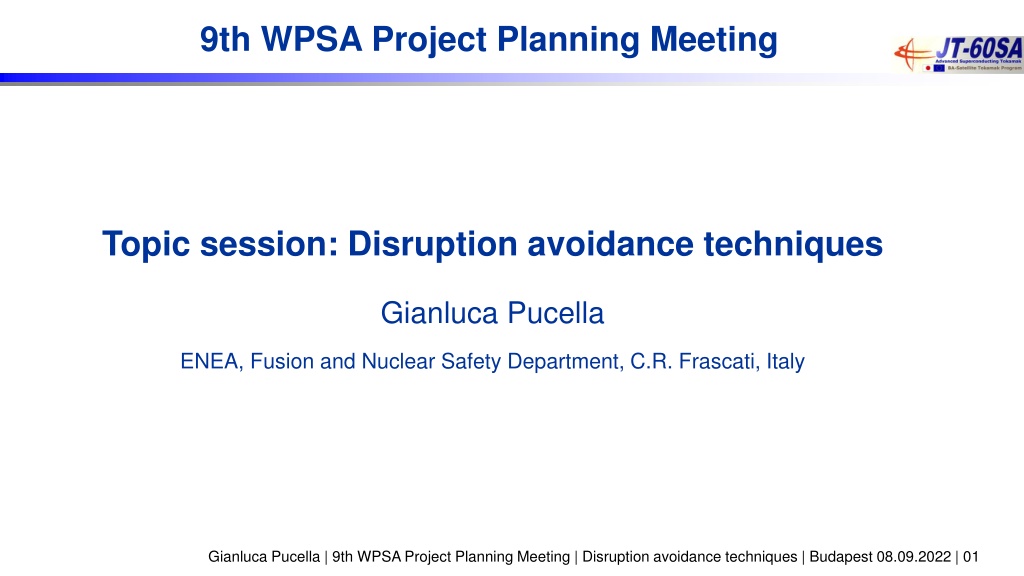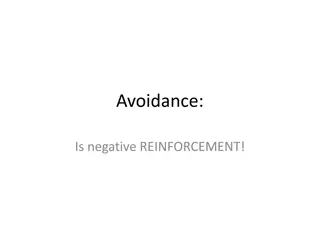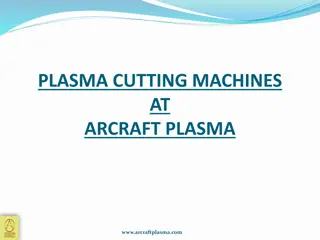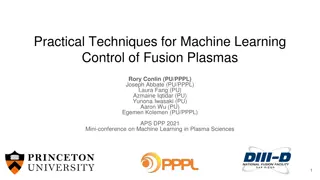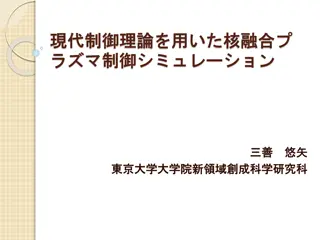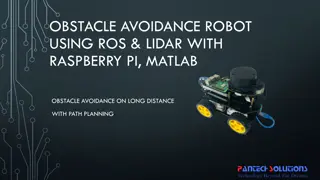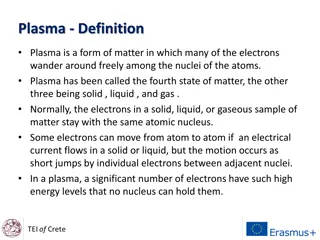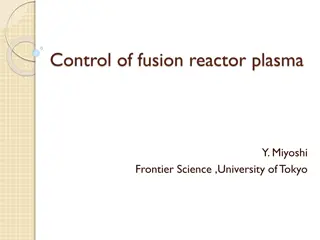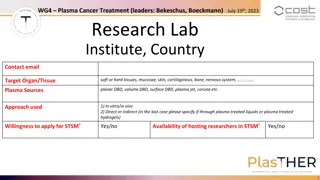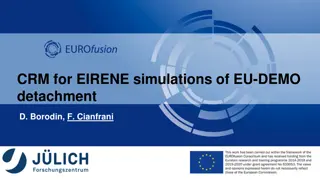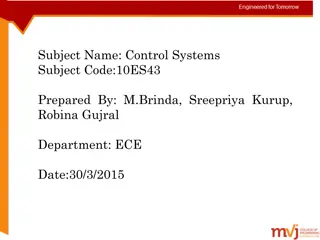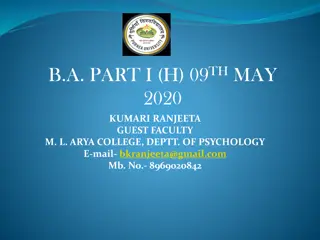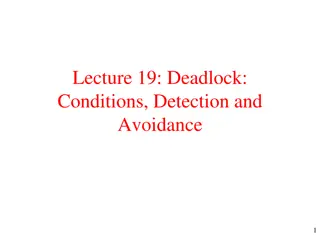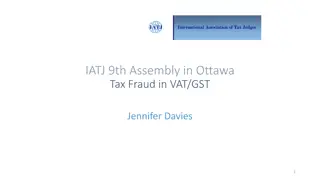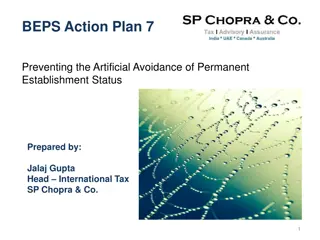Utilizing Disruption Avoidance Techniques in Plasma Control for Enhanced Stability
Exploring disruption avoidance techniques in plasma control is crucial for maintaining stability and safety in operating scenarios. Gianluca Pucella discusses topics such as plasma disruptions, prevention methods, emergency shutdown protocols, and disruption prediction models involving machine learning and physics-driven approaches. These insights help optimize plasma pulses, establish prevention measures, and enhance disruption prediction accuracy, ultimately contributing to a safer fusion environment.
Uploaded on Oct 03, 2024 | 0 Views
Download Presentation

Please find below an Image/Link to download the presentation.
The content on the website is provided AS IS for your information and personal use only. It may not be sold, licensed, or shared on other websites without obtaining consent from the author. Download presentation by click this link. If you encounter any issues during the download, it is possible that the publisher has removed the file from their server.
E N D
Presentation Transcript
9th WPSA Project Planning Meeting Topic session: Disruption avoidance techniques Gianluca Pucella ENEA, Fusion and Nuclear Safety Department, C.R. Frascati, Italy Gianluca Pucella | 9th WPSA Project Planning Meeting | Disruption avoidance techniques | Budapest 08.09.2022 | 01
Plasma disruptions The capability to carried out plasma pulses safely is an important goal towards the optimization of an operating scenario. safety thermal and electromagnetic loads, formation and impact of runaway electrons Disruption limits to the range of accessible plasma parameters scenario disruption prevention plasma control throughout the evolution of the pulse Prevention & shutdown terminate the pulse in a controlled way or alleviate the consequences of unavoidable disruptions emergency shutdown Gianluca Pucella | 9th WPSA Project Planning Meeting | Disruption avoidance techniques | Budapest 08.09.2022 | 02
Disruption prevention & emergency shutdown Disruption prevention is a multi-stage approach covering the full range of control regimes to prevent the disruption. Emergency shutdown involves the anticipated termination of a pulse. Disruption-free protocol (ITPA-IOS) [A. Pau, EPS 2022] REFERENCE SCENARIO PROXIMITY CONTROL ACTIVE AVOIDANCE EMERGENCY SHUTDOWN Keep the target scenario stable again disturbances (ST, ELM, MHD modes, etc.) Keep stability while pushing performance by regulating proximity to stability & controllability boundaries Asynchronous response when crossing operational boundaries (danger levels) Fast controlled shutdown Mitigation Gianluca Pucella | 9th WPSA Project Planning Meeting | Disruption avoidance techniques | Budapest 08.09.2022 | 03
Disruption prediction Data-driven models (derived from machine learning methods, with high accuracy levels (success rate of above 95 %, false alarms rate of few %). training dataset, allowing the model to learn over time Supervised learning: unlabeled data, helping to discover hidden patterns or data clustering Unsupervised learning: ML references Physics-driven models based on physics understanding of the phenomenon involved in a particular class of disruptions. Results easier to interpret in terms of plasma dynamics Large amount of data for training is not required Case study Gianluca Pucella | 9th WPSA Project Planning Meeting | Disruption avoidance techniques | Budapest 08.09.2022 | 04
Machine Learning for disruption prediction Remarkable success in data-driven models for disruption identification and real-time control, including high-performance work models not limited to a specific device. Neural Networks B. Cannas et al 2007 A prediction tool for real-time application in the disruption prediction system at JET Nucl. Fusion 47 1559 R. Yoshino et al 2003 Neural-net disruption predictor in JT-60U Nucl. Fusion 43 1771 Support Vector Machines J. Vega et al 2013 Results of the JET real-time disruption predictor in the ITER-like wall campaigns, Fusion Eng. Des. 88 1228 G. Ratt et al 2010 An advanced disruption predictor for JET tested in a simulated real-time environment, Nucl. Fusion 50 025005 Mapping and Manifold Learning B. Cannas et al 2014 Overview of manifold learning techniques for the investigation of disruptions on JET Plasma Phys. Control. Fusion 56 114005 A. Pau et al 2019 A machine learning approach based on generative topographic mapping for disruption prevention and avoidance at JET Nucl. Fusion 59 106017 Statistical Learning Y. Zhang, G. Pautasso et al 2011 Prediction of disruptions on ASDEX Upgrade using discriminant analysis, Nucl. Fusion 51 063039 S.P. Gerhardt et al 2013 Detection of disruptions in the high- spherical torus NSTX Nucl. Fusion 53 063021 Deep Learning J. Kates-Harbeck, A. Svyatkovskiy and W. Tang 2019 Predicting disruptive instabilities in controlled fusion plasmas through deep learning Nature 568 526 J.X. Zhu et al 2021 Hybrid deep-learning architecture for general disruption prediction across multiple tokamaks Nucl. Fusion 61 026007 Decision Tree, CART, Random Forest, GBM K.J. Montes et al 2019 Machine learning for disruption warnings on Alcator C-Mod, DIII-D, and EAST Nucl. Fusion 59 096015 A. Murari et al 2020 On the transfer of adaptive predictors between different devices for both mitigation and prevention of disruptions, Nucl. Fusion 60 056003 Gianluca Pucella | 9th WPSA Project Planning Meeting | Disruption avoidance techniques | Budapest 08.09.2022 | 05
Current ramp-up of the hybrid scenario at JET Physics understanding: double tearing modes in pulses with hollow Te-profiles [C.D. Challis, Nucl. Fusion 2020] Slower current ramp-up and higher density led to a stable scenario (reference scenario) [G. Pucella, to be submitted] active avoidance Central heating Density control Te-profile peaking factor [M. Fontana FED 2020] included in the JET RT control system [L. Piron FED 2021] Early pulse termination (implemented) emergency shutdown JET MGI system, based on locked mode signals, can be triggered (mitigation) Gianluca Pucella | 9th WPSA Project Planning Meeting | Disruption avoidance techniques | Budapest 08.09.2022 | 06
Hints for discussion 1. Investigate the risk of developing double tearing modes in reversed shear plasmas during fast current ramp-up. Investigate the risk of developing locked modes during the start-up phase of low density plasmas by residual error fields. Stability of classical tearing modes during the plasma termination of pulses with anomalous temperature profiles. Density limit studies in L-mode plasmas. VDE study in high elongated plasmas. Disruption prediction and mitigation using machine learning methods. Development of real-time disruption avoidance/mitigation triggers from physics-driven models, based upon plasma profiles and MHD activity signals. Test/application of an emergency shutdown procedure, by rapidly ramping the plasma current down in a controlled way. Disruption mitigation and physics using massive gas injection. 10. Validation of disruption modelling tools. 2. 3. 4. 5. 6. 7. 8. 9. Gianluca Pucella | 9th WPSA Project Planning Meeting | Disruption avoidance techniques | Budapest 08.09.2022 | 07
